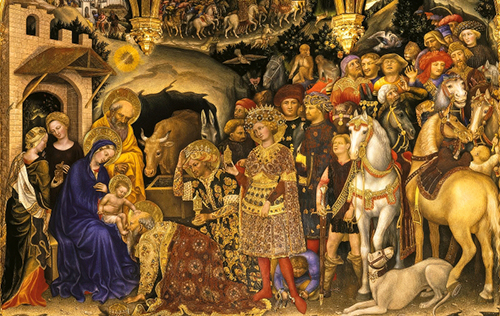St Luke’s gospel has shepherds and no wise men; St Matthew’s gospel has wise men and no shepherds.
However, both the shepherds and the wise men are important to our story of the in-breaking of God into our world in the person of Jesus, the Word made flesh.
The shepherds were Jews, the wise men (or Magi) were non-Jews, or Gentiles.
The word epiphany means a manifestation or revelation. Literally, ‘a drawing back of the veil.’ Imagine sitting in a playhouse and waiting for the curtains to open,
On this day the veil is drawn back on a great mystery, namely, that Christ is the Saviour of all people.
Today is the feast of inclusivity.
This feast shows that election by God is not a privilege for some, rather a hope for all. It puts an end to every kind of exclusiveness.
And what does our Church do? Includes the wealthy (the Magi needed to be persons of some means which enabled them to travel), and excludes the poor – we have no Sunday dedicated to those who received the first manifestation, namely the shepherds.
In Jesus own mission he reached out to those excluded by the society in which he lived; the poor, the diseased, women and children.
He reached out to Samaritans, Canaanites, foreigners, and every manner of social outcast. He angered the Jewish leaders by telling them that the Kingdom of God was open to everyone. The news that the Gentiles would be accepted on equal terms as themselves caused shock and bewilderment to the Jewish leaders.
This great and wonderful truth was revealed in embryo when the Magi and the shepherds came to honour the Christ child.
Are all welcome, as equals, in our Church, irrespective of race, gender, age, sexual preference, ability or disability? If not, why not? Is the barrier not in them; rather, might it be in me?
I have chosen two illustrations for today.
El Greco’s painting of the Adoration of the Shepherds was painted in 1612.

The full painting includes group of angels hovering.
After spending some time with the painting, I made an amazing discovery. Notice the light shining around the naked infant Jesus. Now look at the posture of the adorers’ hands—it is like they are being warmed by the light (fire) of the Word made Flesh.
Gentile de Fabriano illustrated the three Magi. The work is lavish and detailed and was painted as an altarpiece in 1493.

A chocolate fish if you can spot the monkey! And another one when you spot the head of a lioness!
Towards the conclusion of Matthew’s gospel, Jesus is in discussion with the chief priests and elders, and they are questioning his authority. The discussion concludes with these words of Jesus, “Truly I tell you; the tax collectors and prostitutes are going into the kingdom of God ahead of you. For John came to you, in accordance with God’s covenant plan, and you didn’t believe him – but the tax collectors and prostitutes believed him. But when you saw it, you didn’t think better of it afterwards and believe him. “ (Mtt. 21: 31-32)



